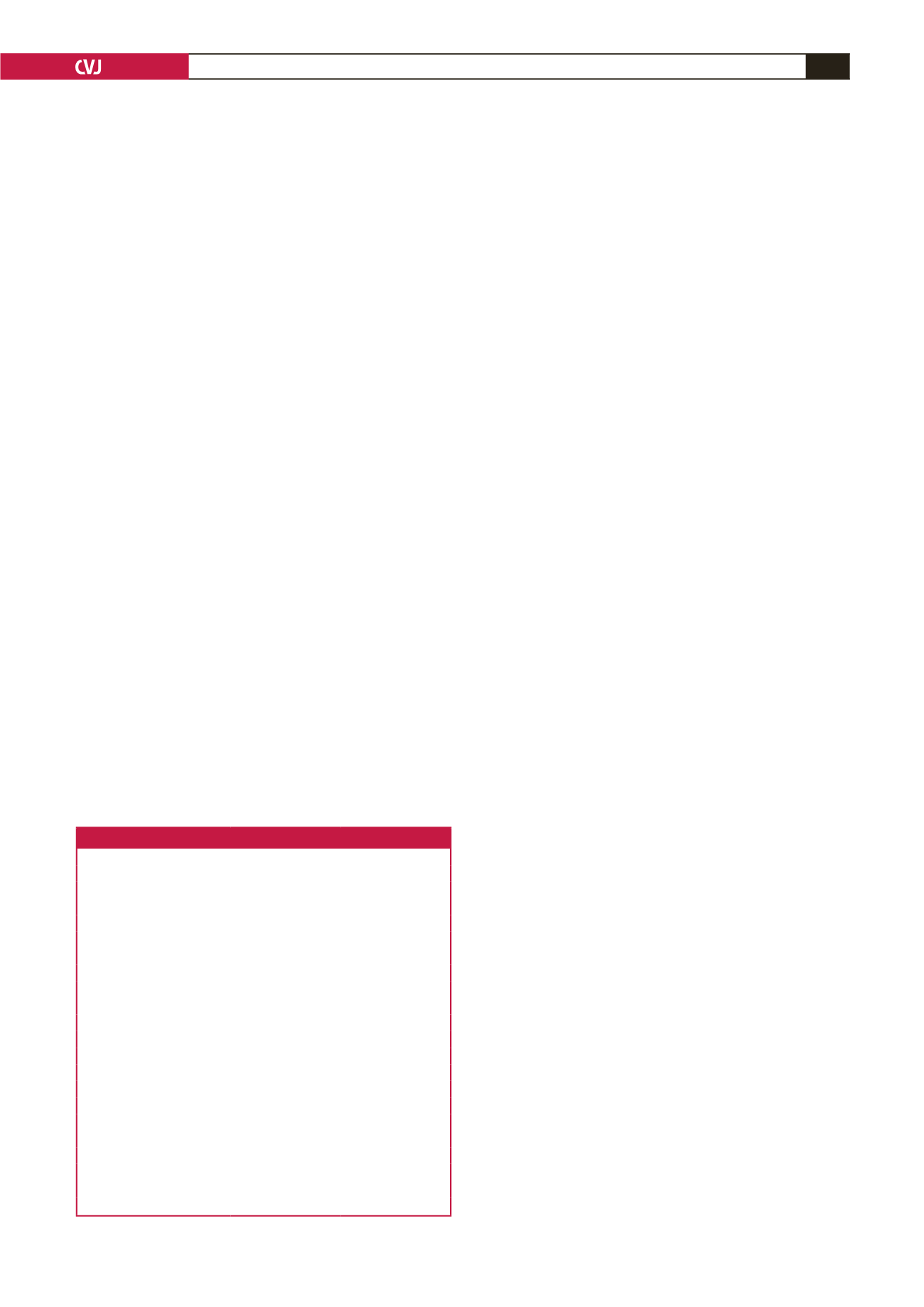

CARDIOVASCULAR JOURNAL OF AFRICA • Volume 27, No 3, May/June 2016
AFRICA
189
Keywords:
cardiology training in South Africa, cardiothoracic
surgery training in South Africa
Submitted 3/2/16, accepted 18/5/16
Cardiovasc J Afr
2016;
27
: 188–193
www.cvja.co.zaDOI: 10.5830/CVJA-2016-063
Why is it important to train specialists in cardio-
vascular care and heart health in South Africa?
The Global Burden of Disease study has highlighted that South
Africa has an unacceptably high proportion of premature
mortality
1
and disability-adjusted life-years (DALYs) lost from
cardiovascular disease. This is largely in part due to marked
increases in hypertensive, rheumatic as well as ischaemic heart
disease, and heart failure due to cardiomyopathy from 1990–
2010.
2
Rapid demographic changes and adaptation to the
so-called Western lifestyle, which includes low physical activity
and high intake of processed high-caloric food, has led to more
than one-third of the population being obese and hypertensive.
3
In South Africa and sub-Saharan Africa (SSA), the spectrum
and manifestation of cardiovascular disease is complex and
markedly different compared to high-income countries, as
rheumatic heart disease (RHD), tuberculous pericarditis and
the cardiomyopathies remain common and often present at an
advanced stage due to cardiac failure.
4
Furthermore, over half
of the patients hospitalised with heart failure are under 52 years
of age.
5
Patients with myocardial infarction are typically two
decades younger than patients in the USA and Europe
6
(Table
1), and RHD becomes symptomatic in adulthood. The onset of
serious heart disease before the sixth decade of life has important
economic and other implications for South African society.
7
A study from the Heart of Soweto cohort, reporting on the
incidence and clinical characteristics of newly diagnosed RHD
in adulthood from an urban African community, found an
estimated incidence of new cases of RHD for those over 14 years
of age to be in the region of 23.5 cases/100 000 per annum.
8
Due
to undetected RHD in the early years, many of those patients
presented late, with left or right heart failure. Subsequently,
one-quarter of this cohort of 344 cases needed valve replacement
or repair within one year, with a further 26% being admitted for
initial diagnosis of suspected bacterial endocarditis within 30
months.
The severity of disease was further corroborated in a recent
study from 12 African countries, including South Africa, India
and Yemen. Patients with RHD were young (median age 28
years), largely female and mostly severely affected.
9
A further
burden of late diagnosis of RHD is the fact that women often
present with symptomatic RHD only when pregnant. A four-
year audit of cardiac disease in pregnancy in a South African
hospital found an aetiology of 63.5% of RHD and 20.1% of
prosthetic valvular heart disease (probably of RHD origin)
among these women.
10
A recent single-centre cohort study of 225 consecutive
women presenting with cardiac disease in pregnancy at a
dedicated cardiac disease in maternity clinic at Groote Schuur
Hospital, Cape Town, highlighted the complex burden of
symptomatic RHD (26%), congenital heart disease (32%) and
severe cardiomyopathy (27%), among other cardiac conditions.
11
Mortality occurred typically in the postpartum period beyond the
standard date of recording maternal death, as also highlighted in
a recent publication in the
Lancet
.
12
The confidential inquiry
into maternal deaths in South Africa reported that, of the 4 867
deaths reported over two years, 14% were due to hypertensive
disorders, with another 8.8% due to medical and surgical
conditions.
13
Medical disorders, in particular cardiac disease
complicating pregnancy, were the fourth most common cause of
maternal death during pregnancy.
Howwell is SouthAfrica prepared to transformour healthcare
system to meet the demands of two colliding and interacting
epidemics: a communicable disease epidemic of HIV/AIDS
and tuberculosis, and a rapidly expanding second epidemic of
non-communicable cardiovascular diseases?
Training of doctors and healthcare personnel
in South Africa
Between 2000 and 2012, the number of medical students
enrolling per annum increased by 34%, with a major and
deliberate demographic shift towards more female students
and African blacks.
14,15
Subsequently, the number of graduating
doctors has increased by 18% in the same time period. However,
the ratio of physicians per 1 000 population remained the same
(0.77 in 2004 vs 0.76 in 2011) and is failing to keep up with the
growth of the population.
15
In response to the fact that the academic health workforce
in South Africa is aging, numbers are shrinking, and there is a
decline in clinical research capacity and output, two new research
training tracks within the professional MB ChB programme have
been created. These are the intercalated BSc (Med) Hons/MB
ChB track and the integratedMB ChB/PhD track.
16
Furthermore,
the Ministry of Health has pledged to train 1 000 clinician PhDs
though the National Health Scholars Programme over the next 10
years, providing scholarships equivalent to the salaries of health
professionals employed by the Department of Health.
16
Table 1. Comparison of age at first myocardial infarction
Region
Medium age, women Medium age, men
Western Europe
68
61
Central and Eastern Europe
68
59
North America
64
58
South America and Mexico
65
69
Australia and New Zealand
66
58
Middle East
57
50
South Asia
60
52
Africa
56
52
China
67
60
South-east Asia and Japan
63
55
Ethnic origin
European
68
59
Chinese
67
60
South Asian
60
50
Other Asian
63
55
Arab
57
52
Latin American
64
58
Black African
54
52
Coloured African
58
52
Other
63
53
Overall
65
56

















